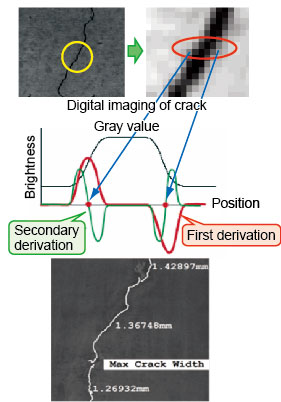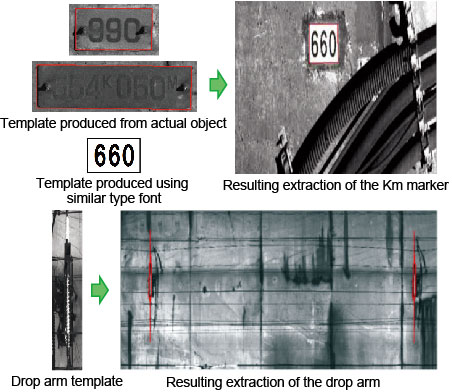6.High precision image processing for detection and evaluation of crack detection
- An image processing method has been developed for detecting the location of cracks in tunnels with a precision of approximately 0.5 mm.
- An algorithm was found for extracting tunnel equipment used as reference criteria for pinpointing cracks.
- An image processing algorithm was obtained for calculating crack density.
Until now basic image processing methods have been developed for extracting deformation such as crack inter alia. However, developing a technique to carry out more detailed inspections has become an issue, since to do so requires accurate knowledge about the position of the deformation of any change and information to a level of precision suited to the scale of that deformation. By adapting the filter processing with the use of brightness gradient of the crack contour being examined, an image processing method was developed to determine crack position within approximately 0.5 mm (Fig.1).
The method relies on a set of templates based on actual objects found in tunnels, such as Km markers and drop arms. Images can be scaled and rotated accordingly by being matched to reference templates of these objects in the system achieving precision of over 90 %. Combining the latter with the image processing algorithm for the extracted images, a method was developed which can accurately determine any displacements in relation to the reference object (Fig.2).
A further algorithm was developed to allow closer examination of the crack once its coordinates have been evaluated, in order to calculate the crack density. To achieve this, the level of precision of the extraction can be tuned according to the portion of the tunnel being investigated.
It is expected that the above methods can improve precise targeting of and cut the time required for certain tasks thanks to prior accurate pinpointing of spots requiring closer investigation, for example detailed examinations with concrete exfoliation detection equipment, inter alia.

Fig.1 High accuracy crack detection method
Fig.2 Results of automatic extraction of tunnel objects